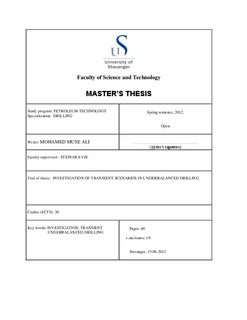| dc.contributor.author | Ali, Mohamed Muse | |
| dc.date.accessioned | 2012-11-07T12:38:54Z | |
| dc.date.available | 2012-11-07T12:38:54Z | |
| dc.date.issued | 2012 | |
| dc.identifier.uri | http://hdl.handle.net/11250/183488 | |
| dc.description | Master's thesis in Petroleum engineering | no_NO |
| dc.description.abstract | When drilling underbalanced wells, the standard way consists to drill with a very low mud weight in order to obtain a well pressure lower than pore pressure. The flow of the fluids from the reservoir up to the tubing is the most cases in two phases, liquid and gas. The pressure at any point in the tubing string is influenced by many factors. By modeling some simple transient scenarios in UBD for the understanding purpose of the physical nature of the flow from the reservoir from which the crude oil or gas is produced. The pressure analysis is the most valuable data from wells which to likely elucidate essentially concerns in the transient the dynamic relation between the producing rate, the bottomhole pressure and the pore pressure. There is a correlation between how easy would be an interpretation of results from simulations and how good and the quality of reservoir description characteristic in the model. One the challenging task remains on obtaining a reliable and accurate description of multiphase flow from a large scale data and heterogeneous reservoir where different types of flow regime coexist in the same wellbore at the same time. Due to the complexity nature of the multiphase flow regime, we studied the drift flux model as well as the fundamental physics behind t9he flow such as mass conservation and momentum conservation in order to simulate realistic models. There are several scenarios simulated in this project by which it is possible to gain information both about the reservoir characteristics and flow behavior in underbalanced wells; the most important are:
Basic case model
Drilling into the reservoir with reservoir inflow
New connection with or without reservoir flow
After comprehensive analysis of the different simulated models, we were able to visualize whether one specific region is operating in the frictional dominated region – due to the mud circulation or gas influx - or hydrostatic dominated side. We play around with rates and productivity index model to visualize the differences existing between these regions in order to minimize bottomhole pressure fluctuations witnessed during pipe connection. | no_NO |
| dc.language.iso | eng | no_NO |
| dc.publisher | University of Stavanger, Norway | no_NO |
| dc.relation.ispartofseries | Masteroppgave/UIS-TN-IPT/2012; | |
| dc.subject | underbalanced drilling | no_NO |
| dc.subject | transient scenarios | no_NO |
| dc.subject | petroleumsteknologi | no_NO |
| dc.subject | boreteknologi | no_NO |
| dc.title | Investigation of transient scenarios in underbalanced drilling | no_NO |
| dc.type | Master thesis | no_NO |
| dc.subject.nsi | VDP::Technology: 500::Rock and petroleum disciplines: 510::Petroleum engineering: 512 | no_NO |
